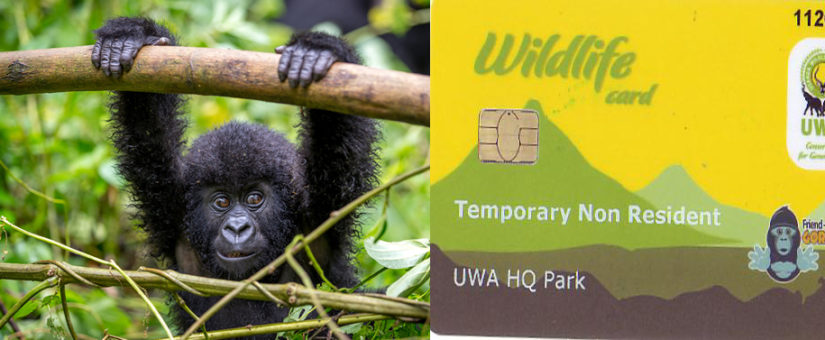There are two species with four sub species of gorillas in the world, the eastern gorillas which include mountain gorillas and eastern lowland gorillas then the western gorillas which include western lowland gorillas and cross river gorillas. The eastern gorillas are found in the Democratic Republic of Congo only, mountain gorillas are found in Uganda, Rwanda and Democratic Republic of Congo, western lowland gorillas are found in Cameroon, Angola, Equatorial Guinea, Central African Republic, Democratic Republic of Congo and Gabon, the cross river gorillas are found in Cameroon and Nigeria.
Thank you for reading this post, don't forget to subscribe!Mountain gorillas are the most species trekked because it is unique and is only done in Uganda, Rwanda and Democratic Republic of Congo in the whole world. It is conducted in the National parks of Bwindi Impenetrable National park in Uganda, Volcanoes National park in Rwanda, Mgahinga National park in Uganda and Virunga National park in Democratic Republic of Congo, however eastern lowland gorillas are also trekked and the activity is done from Kahuzi Biega in Democratic Republic of Congo.
 This experience of encountering the endangered gorilla species in their natural habitats is a breathtaking and unforgettable exercise experienced by the travelers when they get in the forests. Despite the hardships you go through on gorilla trekking, but all the bad feelings will erase when you meet these endangered primates and the process is considered to be for the rich due to charges for tracking in all the 3 countries: currently Rwanda gorilla permit costs 1500 USD, Uganda currently is 600 USD and will be 700 USD starting 1st July 2020 and 400 USD for Democratic Republic of Congo.
This experience of encountering the endangered gorilla species in their natural habitats is a breathtaking and unforgettable exercise experienced by the travelers when they get in the forests. Despite the hardships you go through on gorilla trekking, but all the bad feelings will erase when you meet these endangered primates and the process is considered to be for the rich due to charges for tracking in all the 3 countries: currently Rwanda gorilla permit costs 1500 USD, Uganda currently is 600 USD and will be 700 USD starting 1st July 2020 and 400 USD for Democratic Republic of Congo.
This money is paid throughout the year regardless of the season depending on availability of permits issued from Uganda Wildlife Authority (UWA) in Uganda; Rwanda Development Board (RDB) in Rwanda, in Democratic Republic of Congo is done directly in the park or through tour operators. And for Rwanda’s case the money is paid by all people regardless of your nationality. Reasons as to why gorilla trekking is expensive include:
Critically endangered species
Gorillas are critically endangered species in the world; there are over 1000 mountain gorillas in the forests of Bwindi impenetrable National park, Mgahinga National park, Volcanoes National park, Virunga National park, Kahuzi Biega in Uganda, Rwanda and Democratic Republic of Congo respectively and the western lowland gorillas found in Cameroon, Nigeria, Equatorial Guinea, Central African Republic and Gabon. There are limited gorilla permits for the number of travelers interested in trekking which makes it expensive so as to limit the number of people who want to visit the gorillas. Mountain gorillas are relatives to human beings and catch human diseases easily, so gorilla trekking permits are charged highly to reduce on the overcrowding of travelers in the presence of mountain gorillas.
Conservation and sustainable gorilla tourism
Gorilla trekking permits are expensive so as to limit the number of guests visiting the mountain gorillas as a way to conserve their natural habitats from being destroyed by a number of guests. There was a major loss of the mountain gorillas through poaching and human encroachment on their habitats, for example Rwanda 2017 increased their permits from 750 USD to 1500 USD in order to reduce the number of travelers that visit the apes and to conserve their natural environments where they stay and take shelter. Conserving the mountain gorillas leads to their increase in number which promotes sustainable tourism.
Monitoring and safety
Being endangered species, the gorillas require monitoring and making sure they are safe all the time in the natural habitats especially in their feeding ways, health status. So part of the money paid to Uganda Wildlife Authority, Rwanda Development Board and other bodies regulating wildlife conservation in other countries hire people to monitor the gorillas every day. A group of rangers are sent to the forest to check on the primates every morning and also to make sure there no poachers and encroaches in the gorilla National parks that may harm the gorillas. So part of this money is paid to the employees that ensure conservation and sustainability of the endangered gorillas.
Improve the livelihood of the local people
The tourism sector raises standards of living of the local people that stay in places adjacent to the gorilla national parks. The Government shares parts of the revenue with the local people for example Uganda shares 20% and Rwanda 10% of the money to the local people for infrastructural development like roads, schools, hospitals, and piped water among others to improve their standards of living and benefit from tourism as the first inhabitants of the forests.
With over 1000 gorillas in the world they are only found in countries like Uganda, Rwanda, Democratic Republic of Congo, Cameroon, Central African Republic, Equatorial Guinea, Nigeria, Gabon and Angola. That is why the cost of visiting them is high because they are not seen anywhere else. But the unique specie of mountain gorillas is found in Uganda, Rwanda and Democratic of Congo.
